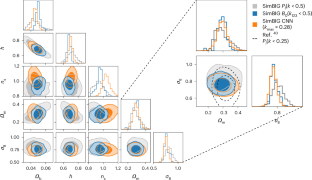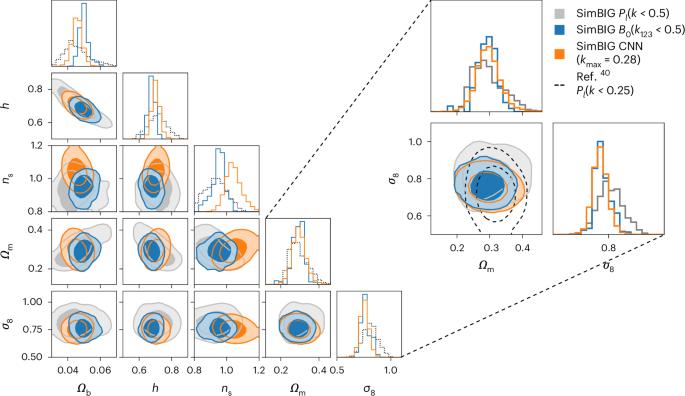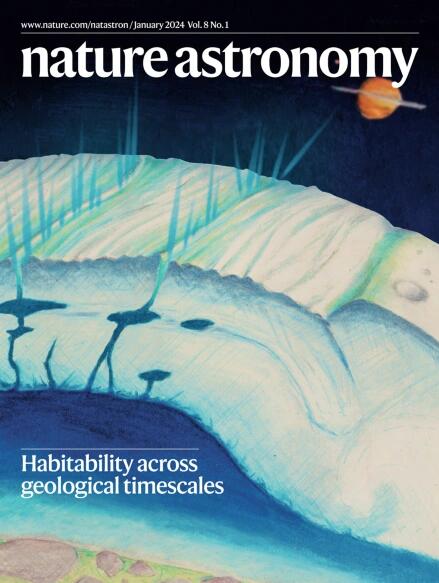Cosmological constraints from non-Gaussian and nonlinear galaxy clustering using the SimBIG inference framework
IF 12.9
1区 物理与天体物理
Q1 ASTRONOMY & ASTROPHYSICS
引用次数: 0
Abstract
The standard ΛCDM cosmological model predicts the presence of cold dark matter, with the current accelerated expansion of the Universe driven by dark energy. This model has recently come under scrutiny because of tensions in measurements of the expansion and growth histories of the Universe, parameterized using H0 and S8. The three-dimensional clustering of galaxies encodes key cosmological information that addresses these tensions. Here we present a set of cosmological constraints using simulation-based inference that exploits additional non-Gaussian information on nonlinear scales from galaxy clustering, inaccessible with current analyses. We analyse a subset of the Baryon Oscillation Spectroscopic Survey (BOSS) galaxy survey using SimBIG, a new framework for cosmological inference that leverages high-fidelity simulations and deep generative models. We use two clustering statistics beyond the standard power spectrum: the bispectrum and a summary of the galaxy field based on a convolutional neural network. We constrain H0 and S8 1.5 and 1.9 times more tightly than power spectrum analyses. With this increased precision, our constraints are competitive with those of other cosmological probes, even with only 10% of the full BOSS volume. Future work extending SimBIG to upcoming spectroscopic galaxy surveys (DESI, PFS, Euclid) will produce improved cosmological constraints that will develop understanding of cosmic tensions. By extracting non-Gaussian cosmological information on galaxy clustering at nonlinear scales, a framework for cosmic inference (SimBIG) provides more precise constraints for testing cosmological models.


利用 SimBIG 推理框架从非高斯和非线性星系聚类得出的宇宙学约束条件
标准ΛCDM 宇宙学模型预言存在冷暗物质,当前宇宙的加速膨胀是由暗能量驱动的。由于宇宙膨胀和增长历史的测量结果存在矛盾,这一模型最近受到了审查,其参数为 H0 和 S8。星系的三维聚类包含了解决这些矛盾的关键宇宙学信息。在这里,我们利用基于模拟的推理,提出了一套宇宙学约束条件,利用了星系团聚非线性尺度上的额外非高斯信息,而这些信息是目前的分析无法获得的。我们利用 SimBIG 分析了重子振荡光谱巡天(BOSS)星系巡天的一个子集,SimBIG 是一个利用高保真模拟和深度生成模型进行宇宙学推断的新框架。我们使用了标准功率谱之外的两种聚类统计:双谱和基于卷积神经网络的星系场摘要。我们对 H0 和 S8 的约束比功率谱分析严格 1.5 倍和 1.9 倍。随着精度的提高,我们的约束与其他宇宙学探测器的约束相比是有竞争力的,即使只有 BOSS 全部体积的 10%。未来的工作将把 SimBIG 扩展到即将开展的光谱星系巡天(DESI、PFS、Euclid),这将产生更好的宇宙学约束,从而加深对宇宙张力的理解。
本文章由计算机程序翻译,如有差异,请以英文原文为准。
求助全文
约1分钟内获得全文
求助全文
来源期刊

Nature Astronomy
Physics and Astronomy-Astronomy and Astrophysics
CiteScore
19.50
自引率
2.80%
发文量
252
期刊介绍:
Nature Astronomy, the oldest science, has played a significant role in the history of Nature. Throughout the years, pioneering discoveries such as the first quasar, exoplanet, and understanding of spiral nebulae have been reported in the journal. With the introduction of Nature Astronomy, the field now receives expanded coverage, welcoming research in astronomy, astrophysics, and planetary science. The primary objective is to encourage closer collaboration among researchers in these related areas.
Similar to other journals under the Nature brand, Nature Astronomy boasts a devoted team of professional editors, ensuring fairness and rigorous peer-review processes. The journal maintains high standards in copy-editing and production, ensuring timely publication and editorial independence.
In addition to original research, Nature Astronomy publishes a wide range of content, including Comments, Reviews, News and Views, Features, and Correspondence. This diverse collection covers various disciplines within astronomy and includes contributions from a diverse range of voices.
 求助内容:
求助内容: 应助结果提醒方式:
应助结果提醒方式:


